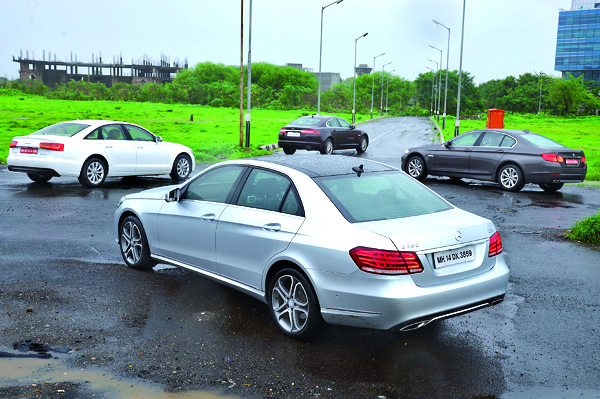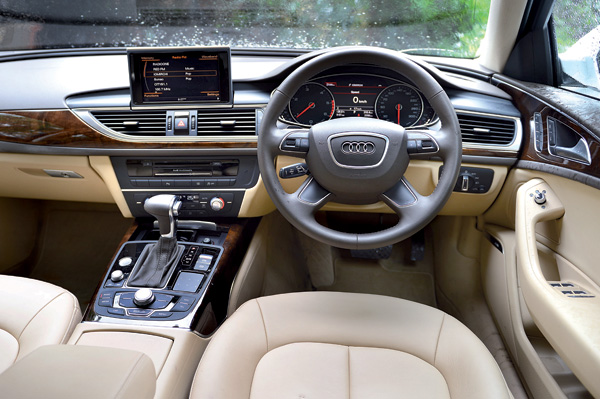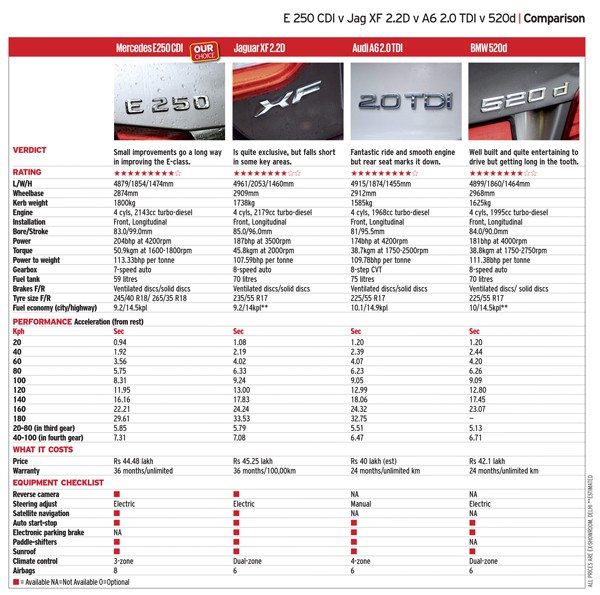Just four years ago, the W212 Mercedes-Benz E-class was the freshest executive luxury saloon around, but pretty soon it became the senior-most citizen of the segment. This highlights the relentless push there is for the latest products, despite the small size of the luxury car market in India.
Manufacturers aren’t waiting anymore and within months or even weeks of an international debut, a new model finds itself on our shores.
Within a year of the E-class’s launch, BMW came out with the new 5-series in the form of 520d and then a year on, Audi brought out its latest A6. And finally, the latest update on the Jaguar XF was introduced last year.
The time is ripe then for Mercedes-Benz to fight back, and it’s doing just that with this luxury saloon, the new E-class. Mind you, the new E-class is not entirely new – it’s still very much the W212 from 2009, but the mid-life updates are quite substantial. The facelift, for example, isn’t just a change of bumpers and headlights. Mercedes has made expensive sheet-metal changes too and given it a few interior upgrades as well. With this facelift, the engines have been rationalised as well. Sadly, the slow-selling E 350 CDI, with its creamy V6, has been discontinued (though there are rumours of it being launched at a later date) and there’s a choice of just two motors now – the E 200 CGI and the E 250 CDI, both four-cylinder motors that do the job without the extra expense and thirst of the V6es.
The fact is that in the Indian market, the chauffeur-driven Sahib is more interested in the image these cars project than how many cylinders they pack under the hood.
It is because of him that the Audi A6 2.0 TDI, for example, outsells its 3.0 TDI sibling by a huge margin. It’s why the Jaguar XF 2.2 diesel helped push its sales up in India by a whopping 68 percent, and why BMW has two lesser diesel engines in its range that sit below the quick but expensive 530d.
It’s all largely to do with price, of course. On average, this Audi A6 2.0 TDI, BMW 520d and Jaguar XF 2.2 cost approximately Rs 10 lakh less than their six-cylinder counterparts, and that puts them all within shouting range of the Mercedes-Benz E 250 CDI’s Rs 44.4 lakh (this Launch Edition we’re driving, which is almost sold out, costs Rs 49.9 lakh). Obviously, we had to bring them together again for a rematch.
Looks and styling
Nothing has presence like an oversized three-pointed star on the nose of a Mercedes-Benz, and that’s exactly what the new E-class has. This is the first time an E-class gets its logo on the grille and the absence of the earlier car’s hood ornament (a big disappointment for badge thieves we’re sure) is part of Merc’s effort to appeal to the younger generation. It’s why the old car’s rather retro ‘pontoon’ flanks have been flattened into tighter, more pert haunches, and the headlamps, tail-lamps and bumpers have been restyled (successfully, if we might add) to make the car look less stately and a lot younger. It’s an interesting look and one that is better proportioned than the generic A6 or rapidly ageing 5-series. Arguably though, the XF still has it. Apart from the 2.2’s slightly weedy looking wheel and tyre combination, the XF still looks contemporary and eye catching.
Under the skin, the Mercedes-Benz E 250 CDI, BMW 520d and Jaguar XF 2.2 follow the traditional big luxury saloon layout of a longitudinal engine powering the rear-wheels, while the Audi A6 sticks with a longitudinal engine that powers the front wheels only. The XF and the 5-series use ZF’s widely acclaimed eight-speed torque-converter automatic, the A6 has an eight-step continuously variable transmission and the E-class comes with Merc’s familiar 7G-tronic seven-speed torque-converter auto. And for those loathe to changing a wheel, this is important – only the Jag comes with a full-size spare wheel; the Audi and the Mercedes have a space saver, while the BMW continues to put its faith (and yours) in run-flat technology.



